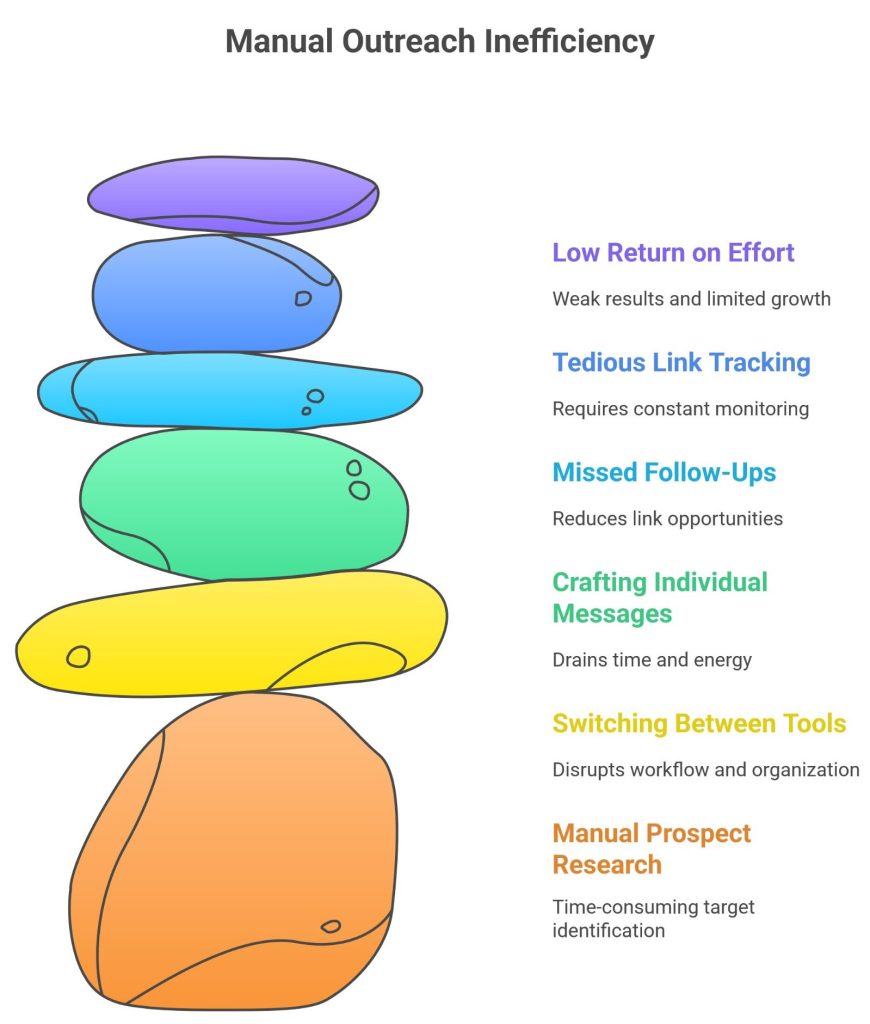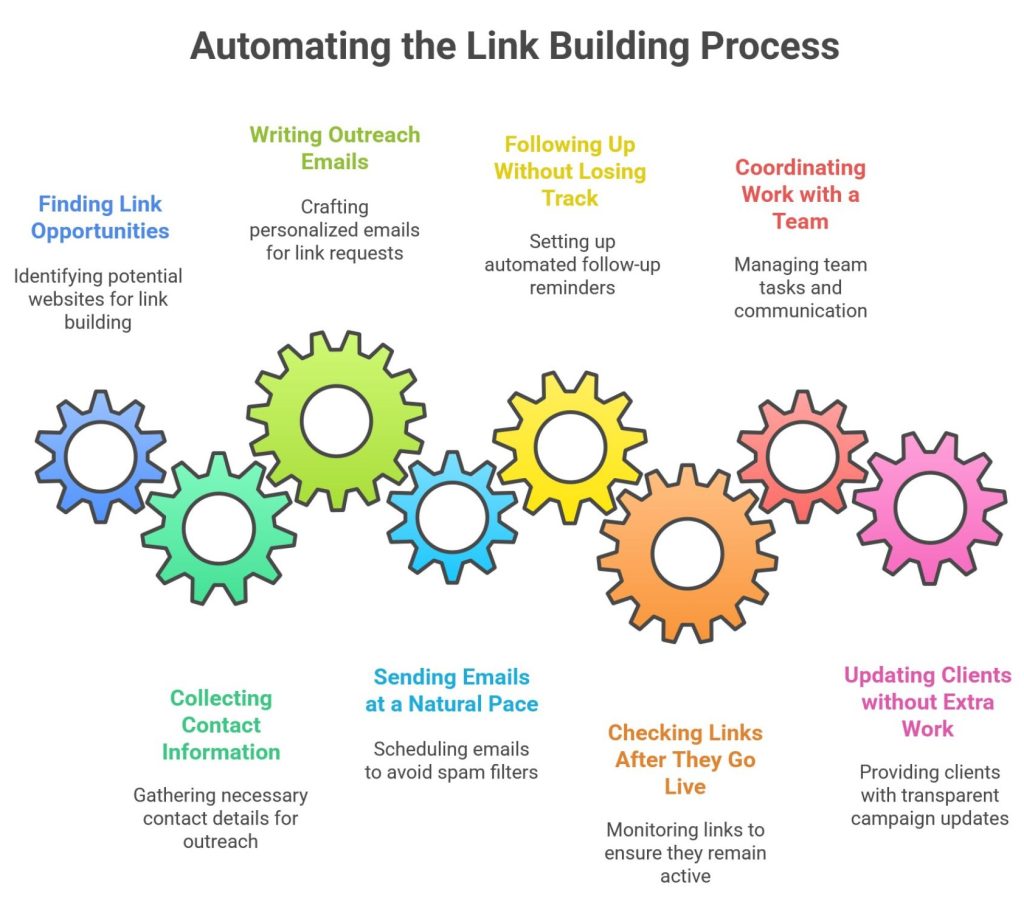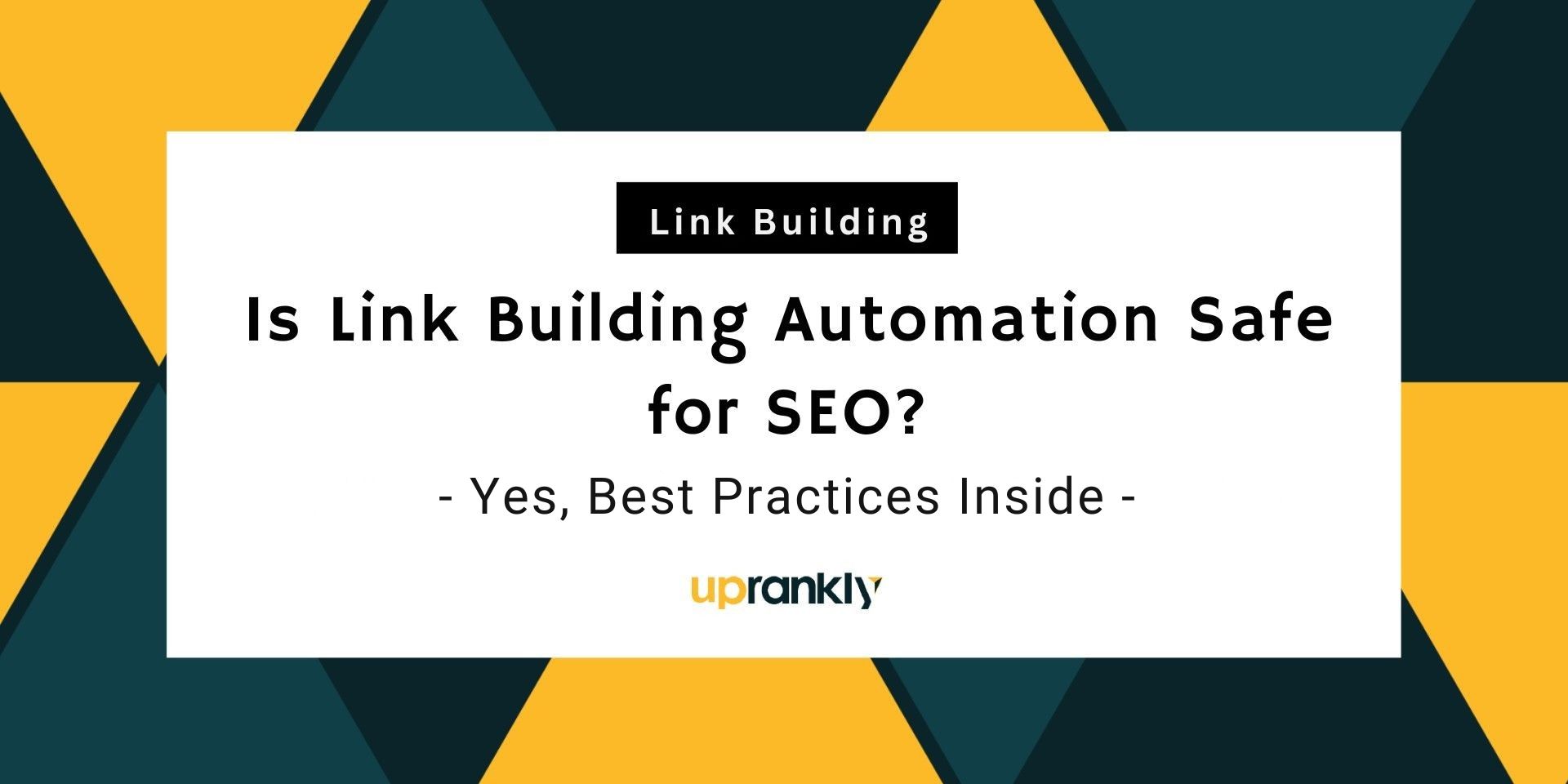Link Building Automation Workflow: A Closer Look at Blogger Outreach Success
Automating blogger outreach becomes simple when you use a link building automation platform that handles the slow steps for you.
A top link-building automation tool finds authoritative prospects, prepares emails, schedules follow-ups, and tracks replies while you focus on strategy.
Here is the process of the link building AI workflow that you can follow,
- Find qualified prospects, check SEO metrics, and pull verified contact details.
- Build simple outreach sequences with personalized emails and scheduled follow-ups.
- Track replies, manage conversations, and monitor backlinks without manual effort.
Let’s explore this Uprankly guide explaining link building automation workflow, how automation saves time, which tools help the process best, and what steps make outreach simple and safe.
What Is Link Building Automation?
Link building automation means using software that streamlines prospecting, email outreach, follow-ups, and link tracking so you build backlinks faster and safely.
Don’t assume that these tools are similar to fully automated link-building tools that place links on low-quality sites.
The tools focus on helping you work smarter to save hours during real outreach.
Most link-building automation tools help you find sites that fit your niche. They also share verified contact information, so you do not spend hours checking emails on many different tools.
As a result, you can create prospect lists in minutes instead of days.
Automation also improves email outreach. You can create simple templates, add light personalization, and send emails on a steady schedule.
Also, the system includes bounce detection to keep your emails safe. You do not need to track replies by hand or spreadsheets. In addition, the tool will stop follow-ups when someone answers. Thus, your blogger outreach remains friendly and natural.
Here, the goal is not to replace real work.
The goal is to remove boring and repetitive tasks. You still choose which sites are good, looking at the SEO metrics and thoroughly checking relevance manually. At the same time, automation makes each step smoother, so you can save hours and focus on real results.
Why Manual Outreach Wastes Hours Every Week

Manual outreach wastes hours every week because every step depends on slow, repetitive actions that do not scale and often distract you from link-building work that matters.
Here are the core reasons:
- Manual Prospect Research: Digging through websites, blogs, and directories for targets takes too long and limits momentum. Without support from tools, you spend hours checking metrics, vetting sites, and avoiding unsafe automated link-building sources that can harm results.
- Switching Tools Slows You Down: Moving between spreadsheets, email tabs, SEO tools, and notes kills workflow speed. Every switch adds friction, increases mistakes, and makes it harder to stay organized, especially when avoiding risky backlink automation platforms.
- Crafting Individual Messages: Writing a personalized pitch for every prospect drains time and energy. You try to balance relevance with speed, but fully manual writing means you can only contact a small number of sites each day.
- Follow-Ups Are Easy to Miss: Tracking replies, timing follow-ups, and remembering who responded becomes chaotic without support. Missed follow-ups reduce link opportunities and create inconsistency across your outreach workflow.
- Link Tracking Is Tedious without Automation: Manually checking if links are live, changed, removed, or nofollowed requires constant attention. This ongoing monitoring eats hours every week and increases the chance of missing important updates.
- Low Return on Effort: Manual tasks demand high energy yet often bring weak results. Slow processes, generic messages, and no scaling ability mean fewer replies, fewer placements, and limited long-term growth.
How to Automate the Link Building Process

You can automate the building process by using a link-building tool that finds prospects, prepares emails, schedules follow-ups, gives campaign performance, tracks replies, and backlink status without manual work.
Here is how to automate the building process using SEO tools.
Step 1: Finding Link Opportunities
Most beginners rely on Google searches for guest posting pages, resource lists, or niche sites. Each potential target needs a manual check for domain authority, traffic, and the backlink profile. A few checks feel manageable, yet the workload grows quickly once you aim for dozens of links.
A more efficient approach involves entering a keyword or niche inside an automation platform. You will see a list of relevant websites pulled for you automatically.
Typical platforms show:
- Relevance to Your Niche
- Key SEO data like DA, Traffic
Many tools also display contact names or verified email addresses right beside each site. A clean list of filtered link opportunities appears in minutes, not hours.
Step 2: Collecting Contact Information
Most manual workflows include digging through About pages, author bios, and social profiles to find emails. Several tools are usually needed to verify addresses, which slows everything down.
Automation handles the heavy lifting. A single search often returns the correct contact info, along with checks that reduce bounce risk. Many tools rely on bounce detection to protect outreach quality. A clean outreach list forms much faster, without leaning on shady automated link-building practices.
Step 3: Writing Outreach Emails
A personalized pitch boosts replies, yet writing one message at a time drains energy. A template helps, although editing every version still takes time and focus.
A more straightforward approach involves using built-in writing assistance. A simple base email can be enhanced with small suggestions from AI-powered tools. Tone, clarity, and personalization improve without requiring a complete rewrite. Nothing about this resembles unsafe backlink automation—the message still comes from you, only faster.
Step 4: Sending Emails at a Natural Pace
Manual outreach often leads to rushed batches of emails, unpredictable timing, and inbox limits. Deliverability drops, which hurts future campaigns.
A healthier rhythm comes from automated scheduling. Messages go out at controlled times, spread across safe hours. Email accounts rotate naturally, preventing overload. Outreach feels steady and reliable instead of chaotic, and no dangerous autolink building patterns appear.
Step 5: Following Up Without Losing Track
Follow-ups play a significant role in outreach success, yet most people forget them while juggling other tasks. Timing mistakes lead to missed chances.
Automated follow-ups solve the problem. You can choose delays, set conditions, and let the system send reminders only when no reply exists. A single setup keeps every conversation moving forward without extra effort.
Step 6: Checking Links After They Go Live
Many link builders spend hours each month opening URLs to confirm anchors, statuses, and link placement. Manual checks feel repetitive and easy to avoid.
Automated monitoring changes everything. Alerts appear whenever a link disappears, redirects, or becomes nofollow. A stable link profile forms naturally, and search engines see stronger signals. No shady automated link building is involved—just steady protection of earned work.
Step 7: Coordinating Work with a Team
Teams relying on spreadsheets and scattered messages often lose track of tasks. Miscommunication leads to duplicate outreach or forgotten follow-ups.
Modern platforms include strong link building team management features. Everyone receives clear assignments, shared notes, and updated progress. A structured workflow replaces the usual confusion, allowing teams to scale outreach safely.
Step 8: Updating Clients without Extra Work
Client reporting becomes overwhelming when every update requires screenshots, manual notes, and long email threads.
Shared campaign views reduce that load. Clients can review approved sites, pending work, and live high-quality links whenever they want. Fewer questions reach your inbox, and the whole outreach process feels more transparent.
What are the Best Practices to Keep the Link Building Automation Workflow Safe?
Safe link building automation relies on reviewing every site manually, keeping outreach personal, avoiding spam patterns, using verified contacts, limiting daily sends, and tracking link changes to protect long-term results.
Find and follow the link building automation best practices for outreach success and avoid automation risks.
- Review every website manually to avoid unsafe targets and protect outreach campaigns.
- Keep personalization short to support genuine relationship building at scale.
- Use verified contacts only to reduce bounce risk and improve deliverability.
- Limit daily sending volume to keep email accounts safe and trusted.
- Avoid spammy templates and write friendly, simple messages for real people.
- Track link changes often to maintain a clean and stable backlink profile.
- Rotate email accounts wisely to protect sender reputation during outreach campaigns.
What are the Best Link Building Automation Tools That Make the Manual Process Easier?
Respona, Pitchbox, and BuzzStream are the top link building automation tools that help you find prospects faster, send better outreach, manage replies, and track links so manual work becomes much easier.
Respona
Many marketers use Respona when they want an outreach platform that balances automation with strong research features. The tool suits teams who care about precision and want better results from outreach tools without losing control of quality. A smoother workflow forms because prospecting, backlink analysis, and email outreach all happen in one place.
Main Features
- Content Discovery: Finds targeted opportunities through advanced search operators and filters.
- AI Email Personalization: Creates natural email openers that boost early engagement.
- Prospect Metrics: Displays domain quality signals to reduce risky outreach decisions.
Benefits
- Faster, cleaner prospecting workflow
- Better personalization with AI
- Higher response rates overall
Drawback
- Limited flexibility for complex Backlink Gap research
Pitchbox
Pitchbox fits teams that manage large outreach tools workflows and need strong automation with an organized structure. Agencies often choose it because the system centralizes prospecting, campaign management, and personalization. Many users appreciate how the tool blends research, backlink analysis, follow-ups, and smart rules into one coordinated outreach environment.
Main Features
- Full-Stack Prospecting: Pulls opportunities using deep discovery methods and filters.
- AI Contact Discovery: Scores outreach targets before you send any email.
- Natural Email Sending Patterns: Protects deliverability with safe scheduling behavior.
Benefits
- Strong scaling for big teams
- Reliable automated follow-ups
- Smooth CRM-style management
Drawback
- Limited clarity when spotting a Backlink Gap
BuzzStream
BuzzStream works well for link builders who want a CRM-style outreach environment. Many teams choose it because relationship management, prospecting, and email outreach stay neatly connected. The platform helps you organize contacts, track communication history, and keep outreach tools aligned while you build long-term relationships that support stronger backlink analysis work.
Main Features
- Prospect Research: Collects website metrics automatically for cleaner targeting.
- Relationship Tracking: Stores contact details, notes, and communication history.
- Automated Outreach: Sends personalized emails with built-in auto-reply detection.
Benefits
- Strong contact organization
- Great for relationship building
- Clear campaign insights
Drawback
- Weak support for detailed Backlink Gap checks
FAQ
Is link building automation safe?
Link building automation is safe when you stay in control, review every site, personalize messages, and focus on quality. Tools only remove repetitive work. You choose targets, approve outreach, and protect your brand from risky shortcuts.
What tasks can I automate with link building automation tools?
You can automate prospect discovery, contact finding, email scheduling, follow-ups, link tracking, and basic reporting. These tasks usually consume hours, yet automation tools handle them quickly while keeping you focused on quality and strategy.
Are link building automation and fully automated link building the same?
Link building automation supports your workflow, while fully automated link building tries to create links without human review. One saves time safely. The other can damage your site and break search engine guidelines.
Do I need human input during the building automation process?
Human input is essential because you must review websites, choose targets, adjust messages, and guide outreach. Tools support your work, but strategic decisions, judgment, and brand protection always require a human to stay involved.
Wrapping Up
Blogger outreach workload becomes easier once link building automation tools remove the slow, repetitive steps from your process. Prospecting speeds up, emails get handled on a steady schedule, and link tracking stays organized without constant checking.
A smoother link building automation process forms because the tool manages the tasks that drain time, while you focus on judgment, relevance, and real conversations. Strong link-building results come from a simple balance: automation handles the busywork, and you guide the strategy that keeps outreach effective.

